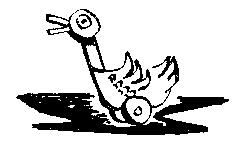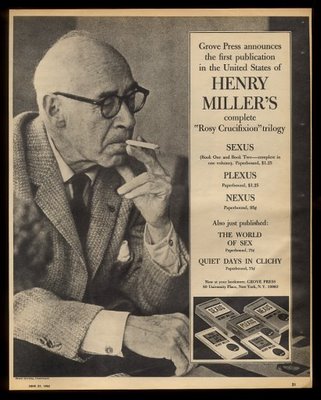Six Degrees To The Black Dahlia Murder
 While watching a TV documentary earlier this year about the infamous Black Dahlia murder, I came to wonder if there was even a slight connection to the events surrounding it and Henry Miller. He lived in the general region around that time period. My link is very trivial, so I wondered whether to even post it; but this blog is about Miller trivia, big and small. So, why not.
While watching a TV documentary earlier this year about the infamous Black Dahlia murder, I came to wonder if there was even a slight connection to the events surrounding it and Henry Miller. He lived in the general region around that time period. My link is very trivial, so I wondered whether to even post it; but this blog is about Miller trivia, big and small. So, why not.You may read about the murder case here, here, here or here. Budding young Hollywood hopeful Elizabeth Short was found hacked in two in Leimert Park, L.A. on Janury 15, 1947. She was last seen alive on January 9th. The case was never solved and the list of "possible" suspects has grown in the following decades to questionable dimensions. Besides the 22 men investigated by the DA's office, some far-out theories finger celebrities like Orson Welles.
One suspect was Dr. George Hodel, whose supposed guilt was recently decalred by his son in the book, Black Dahlia Avenger. It should be noted that the factual strength of this book has been disputed. And here lies my rickety connection to Miller. In this book, Steven Hodel makes passing mention of Henry: "Another of Dad’s acquaintances, and Man Ray’s as well, was the novelist Henry Miller, whom Joe remembered seeing talking to Father in his library." (p.211, paperback ed.) Yep, that's all I have. If Miller had in fact met Hodel, it was likely through Man Ray, who'd been his neighbour while he was staying with the Neimans.
Some people have suggested that Man Ray's art played some role in the manner of the victim's mutilation. This is explored mostly in the book Exquisite Corpse. Here's someone's analysis of this theory.
Though he had lived in L.A. in the mid-40s, Henry Miller was living in Big Sur at the time of the muder. He wrote to James Laughlin from there on January 1, 1947. In a letter to Lawrence Durrell on February 9th, 1947, Miller states that he was "recently" in San Franciso (where he saw a film), but otherwise he was in Big Sur (a few weeks away from moving into his new house on Partington Ridge). I point these facts out to calm the potential conspiracy theorist who might think that I'm implying that Miller had even the most remote chance of being involved with this crime. Absolutely not! As I said, this is just a minor trivial connection to a contemporary event outside of his own life.
Incidentally, Henry was living in the Pacific Pallisades, probably working on watercolours, when JFK was shot.

 On the Chicago Review webiste, this backstory is given about the article:
On the Chicago Review webiste, this backstory is given about the article: (the duck graphic above is from the original Chicago Review article. The dead duck in the banner art is made of rubber and available for sale from a variety of on-line stores)
(the duck graphic above is from the original Chicago Review article. The dead duck in the banner art is made of rubber and available for sale from a variety of on-line stores) Sorry if the postings come a bit slow over the next few weeks. 'Tis the holiday season and all.
Sorry if the postings come a bit slow over the next few weeks. 'Tis the holiday season and all.

 20.4
20.4 
